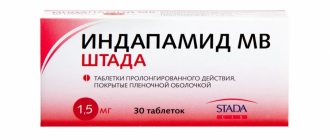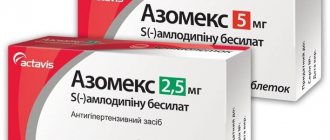Analogs
Level 4 ATC code matches: Khairabesol
Noflux
Lancid
Barol
Beret
Ontime
Gastrozol
Omeprazole
Pantoprazole
Proxium
Lansoprazole
Zulbex
Ultop
Epicurus
Pariet
Losek MAPS
Losek
Sanpraz
Emanera
Omez Insta
Ortanol analogues: Omez , Gasec , Loseprazole , Omelik .
Many people are interested in Orthanol or Omez - which is better? It all depends on the human body.
Instructions for use ORTANOL® (ORTANOL)
Adults
For duodenal ulcer
the standard dose is 20 mg 1 time/day for 2 weeks. If necessary, the course of treatment can be increased to 4 weeks. In some cases, the dose of omeprazole can be increased to 40 mg 1 time / day.
To prevent relapse of duodenal ulcer
the standard dose is 20 mg/day. If necessary, the dose can be increased to 40 mg 1 time / day.
For benign gastric ulcer
the standard dose is 20 mg 1 time / day for 4 weeks. If necessary, the course of treatment can be increased to 6-8 weeks. In some cases, the dose of omeprazole can be increased to 40 mg 1 time / day.
To prevent relapse in gastric ulcers
the standard dose is 20 mg/day. If necessary, the dose can be increased to 40 mg 1 time / day.
For reflux esophagitis
the standard dose is 20 mg 1 time / day for 4 weeks. If necessary, the course of treatment can be increased to 8 weeks. In some cases, with reflux esophagitis, the dose of omeprazole can be increased to 40 mg 1 time / day.
For maintenance therapy of reflux esophagitis to prevent relapse
the standard dose is 20 mg. If necessary, the dose of omeprazole can be increased to 40 mg 1 time / day.
For Zollinger-Ellison syndrome
The dose is recommended to be selected individually with continued therapy under the supervision of a specialist. The duration of therapy depends on clinical indications. The recommended starting dose is 60 mg/day. If the dose of the drug exceeds 80 mg/day, it should be divided into 2 doses. In patients with Zollinger-Ellison syndrome, treatment is not limited in time.
For the treatment of gastric and duodenal ulcers associated with the use of NSAIDs
the standard dose is 20 mg 1 time / day for 4 weeks. If necessary, the course of treatment can be increased to 8 weeks.
Prevention of relapse in gastric and duodenal ulcers caused by the use of NSAIDs:
in the risk group (patients over 60 years of age, a history of gastric or duodenal ulcer, a history of gastrointestinal bleeding), it is recommended to take omeprazole at a dose of 20 mg 1 time/day.
Symptomatic treatment of gastroesophageal reflux disease:
the standard dose is 20 mg depending on response to treatment. Duration of treatment is from 2 to 4 weeks.
If the patient does not notice improvement after 2 weeks of therapy, a more thorough examination should be performed.
Eradication of Helicobacter pylori
Patients with peptic ulcer associated with Helicobacter pylori infection
, should receive eradication therapy using appropriate combinations of antibiotics and adequate dosing regimens. The choice of the appropriate regimen should be based on individual patient tolerance and therapeutic guidelines. The following combinations were tested:
- omeprazole 20 mg, amoxicillin 1000 mg, clarithromycin 500 mg, 2 times a day each drug;
- omeprazole 20 mg, clarithromycin 250-500 mg, metronidazole 400-500 mg, 2 times a day each drug;
- omeprazole 40 mg 1 time/day, amoxicillin 500 mg, metronidazole 400-500 mg 3 times/day.
The duration of eradication therapy is 1 week. To avoid the development of resistance to therapy, it is not recommended to reduce the duration of treatment.
In patients with active peptic ulcers, treatment can be continued with omeprazole as monotherapy in accordance with the principles of dose selection and duration of therapy described above.
Due to the carcinogenic potential of metronidazole, combination therapy including metronidazole should not be the first option on the list of possible treatments. The period of treatment with metronidazole should not exceed 10 days.
Children
Clinical experience with the drug in children is limited. Omeprazole should be prescribed to children only in cases of severe reflux esophagitis
resistant to other types of therapy. Treatment should be started by a pediatrician in the clinic.
Continuous pH measurement and genotyping (for CYP2C19 status) can be performed to obtain an optimal therapeutic response.
Children over 1 year of age weighing > 10 kg
For the treatment of reflux esophagitis and symptomatic treatment of gastroesophageal reflux disease
The recommended dose of the drug is 1 mg/kg/day:
- with body weight more than 20 kg
- 20 mg/day; - if necessary, the dose can be increased to 40 mg 1 time / day.
Duration of therapy for reflux esophagitis
usually ranges from 4 to 8 weeks, for
gastroesophageal reflux disease
- 2-4 weeks and should not exceed 12 weeks, because There are no data on long-term use of the drug in this age group.
Children over 4 years old and teenagers
Combination therapy in accordance with antibacterial therapy regimens for the treatment of duodenal ulcer associated with Helicobacter pylori
With body weight from 31 to 40 kg
- omeprazole 20 mg, amoxicillin 750 mg and clarithromycin 7.5 mg/kg, 2 times a day for one week.
With body weight >40 kg
- omeprazole 20 mg, amoxicillin 1 g and clarithromycin 500 mg, 2 times a day for one week.
Special patient groups
In elderly patients and in patients with impaired renal function
no dose adjustment is required.
In patients with impaired liver function
the bioavailability and T1/2 of omeprazole may increase, so the maximum dose of the drug is 20 mg/day.
Rules for using the drug
The capsules are swallowed with a sufficient amount of liquid (for example, a glass of water) before meals (for example, before breakfast or lunch) or on an empty stomach. Capsules should not be crushed or chewed.
When using the drug in children and adult patients who have difficulty swallowing, you can open the capsule and take its contents with half a glass of water or mix the contents with fruit juice, applesauce or still water. The resulting solution should be taken immediately after preparation or within 30 minutes, stirred before use and washed down with half a glass of water. The granules should not be chewed.
Orthanol price, where to buy
The average price of a heartburn remedy in Russia is 145 rubles.
The price of Orthanol in Ukraine is 95 UAH.
- Online pharmacies in RussiaRussia
ZdravCity
- Orthanol capsules 20 mg 28 pcs. Lek dd
RUB 125 order - Orthanol capsules 20 mg 14 pcs. Lek dd
91 rub. order
- Orthanol capsules 10 mg 28 pcs. Lek dd
162 RUR order
Orthanol, 10 mg, capsules, 14 pcs.
When used concomitantly with omeprazole, there may be an increase or decrease in the absorption of drugs whose bioavailability is largely determined by the acidity of gastric juice (including erlotinib, ketoconazole, itraconazole, posaconazole, iron supplements and cyanocobalamin). Concomitant use of omeprazole with posaconazole and erlotinib is contraindicated.
When used concomitantly with omeprazole, a significant decrease in plasma concentrations of atazanavir and nelfinavir may be observed. The simultaneous use of these drugs is not recommended.
When used simultaneously with omeprazole, an increase in plasma concentrations of saquinavir/ritonavir is observed up to 70%, while the tolerability of treatment in patients with HIV infection does not deteriorate.
The bioavailability of digoxin when used simultaneously with 20 mg of omeprazole increases by 10%. Caution should be exercised when these drugs are used concomitantly in elderly patients.
When used simultaneously with omeprazole, it is possible to increase the plasma concentration and increase T1/2 of warfarin (R-warfarin) or other vitamin K antagonists, cilostazol, diazepam, phenytoin, as well as other drugs metabolized in the liver via the CYP2C19 isoenzyme (a dose reduction of these drugs may be required ). However, concomitant therapy with omeprazole 20 mg does not affect plasma phenytoin concentrations in patients taking the drug for a long time. When using omeprazole in patients receiving warfarin or other vitamin K antagonists, it is necessary to monitor MHO; in some cases, it may be necessary to reduce the dose of warfarin or another vitamin K antagonist. At the same time, concomitant treatment with omeprazole at a daily dose of 20 mg leads to a change in coagulation time in patients taking warfarin for a long time.
The simultaneous use of clopidogrel and omeprazole should be avoided (it is recommended to consider alternative methods of antiplatelet therapy), because when used together, the plasma concentration of clopidogrel decreases by 46% on the 1st day of use and by 42% on the 5th day of use. However, the use of drugs at different times of the day does not exclude the possibility of their interaction.
Omeprazole, when used simultaneously, increases the plasma concentration of tacrolimus, which may require dose adjustment. During combination treatment, tacrolimus plasma concentrations and renal function (creatinine clearance) should be carefully monitored.
In some patients, an increase in plasma concentrations of methotrexate was observed during simultaneous use with proton pump inhibitors. When using high doses of methotrexate, the possibility of temporary discontinuation of the drug should be considered.
Concomitant use with inhibitors of the CYP2C19 and CYP3A4 isoenzymes (such as clarithromycin, voriconazole) can lead to an increase in the plasma concentration of omeprazole by more than 2 times, which may require dose adjustment of omeprazole in patients with severe liver failure in case of long-term use. However, due to the good tolerance of high doses of omeprazole, short-term simultaneous use of these drugs does not require dose adjustment.
Inducers of CYP2C19 and CYP3A4 isoenzymes (for example, rifampicin, preparations of St. John's wort ( Hypericum perforatum
) when used simultaneously with omeprazole, can increase its metabolism, thereby reducing its concentration in plasma.
No clinically significant interaction of omeprazole with antacids, theophylline, caffeine, S-warfarin, piroxicam, diclofenac, naproxen, quinidine, lidocaine, propranolol, metoprolol, ethanol has been established.
Ortanol®
The effect of omeprazole on the pharmacokinetics of other drugs
A decrease in the secretion of hydrochloric acid in the stomach during treatment with omeprazole may lead to a decrease or increase in the absorption of other drugs, the bioavailability of which is largely determined by the acidity of the gastric juice (including posaconazole, erlotinib, ketoconazole, itraconazole, digoxin, iron supplements and cyanocobalamin) .
Concomitant use of omeprazole with posaconazole and erlotinib should be avoided.
With the simultaneous use of atazanavir and nelfinavir with omeprazole, a significant decrease in their plasma concentrations may be observed; therefore, the simultaneous use of these drugs is not recommended.
The bioavailability of digoxin when used simultaneously with omeprazole increases by 10%. Particular caution should be exercised when these drugs are used concomitantly in elderly patients.
In a crossover clinical study, clopidogrel (loading dose 300 mg, maintenance dose 75 mg per day) as monotherapy and in combination with omeprazole (80 mg per day simultaneously with clopidogrel) was used for 5 days. At the same time, the bioavailability of the active metabolite of clopidogrel decreased by 46% (day 1) and 42% (day 5), the level of inhibition of ADP-induced platelet aggregation decreased by 47% (day 1) and 30% (day 5) with simultaneous use of omeprazole and clopidogrelated. Another study found that the use of clopidogrel and omeprazole at different time points does not exclude their interaction, which is likely due to the inhibitory effect of omeprazole on the activity of the CYP2C19 enzyme. In the course of observations and clinical studies, conflicting data were obtained regarding the presence or absence of an increased risk of developing cardiovascular complications with the simultaneous use of omeprazole and clopidogrel.
When used simultaneously with omeprazole, it is possible to increase the plasma concentration and increase the half-life of warfarin (II-warfarin) and other vitamin K antagonists, cilostazol, diazepam, phenytoin, as well as other drugs metabolized in the liver via the CYP2C19 isoenzyme (a dose reduction of these drugs may be required) .
When using omeprazole in patients receiving warfarin or other vitamin K antagonists, careful monitoring of the international normalized ratio (INR) is necessary. In some cases, it may be necessary to reduce the dose of warfarin or another vitamin K antagonist. At the same time, in patients taking warfarin for a long time, co-administration of omeprazole at a dose of 20 mg once daily did not cause a change in coagulation time.
The use of omeprazole at a dose of 40 mg once daily in healthy volunteers increased the Cmax and AUC of cilostazop by 18% and 26%, respectively; for one of the active metabolites of schiustazol, the increase was 29% and 69%, respectively.
When using phenytoin concomitantly, it is recommended to measure phenytoin plasma concentrations during the first two weeks after starting treatment with omeprazole. In some cases, a dose adjustment of phenytoin may be required. At the same time, in patients taking phenytoin for a long time, simultaneous use with omeprazole at a dose of 20 mg once a day did not cause a change in the concentration of phenytoin in the blood plasma. Omeprazole, when used simultaneously, increases the plasma concentration of tacrolimus, which may require dose adjustment. It is necessary to monitor the concentration of tacrolimus in the blood plasma, as well as measure creatinine clearance.
When used concomitantly with omeprazole, an increase in plasma concentrations of saquinavir/ritonavir is observed by up to 70%, while the tolerability of treatment in patients with HIV infection does not deteriorate.
In some patients, an increase in methotrexate concentrations was observed during combined use with PPIs. When prescribing high doses of methotrexate, the possibility of temporary withdrawal of omeprazole should be considered.
Omeprazole does not affect the metabolism of drugs metabolized by the CYP3A4 isoenzyme, such as cyclosporine, lidocaine, quinidine, estradiol, erythromycin and budesonide.
Effect of drugs on the pharmacokinetics of omeprazole
Concomitant use with inhibitors of the CYP2C19 and CYP3A4 isoenzymes (such as clarithromycin, voriconazole) may lead to an increase in the plasma concentration of omeprazole by slowing its metabolism. Concomitant use of omeprazole and voriconazole may result in an increase in the AUC of omeprazole by more than 2 times. As a rule, in such cases no dose adjustment of omeprazole is required, however, this may be required in patients with severe liver dysfunction and with long-term use of omeprazole.
Inducers of the CYP2C19 and CYP3A4 isoenzymes (for example, rifampicin, St. John's wort (Hypericum perforatum) preparations) can accelerate the metabolism of omeprazole, thereby reducing its concentration in the blood plasma.
No clinically significant interaction of omeprazole with antacids, theophylline, caffeine, S-warfarin, piroxicam, diclofenac, naproxen, quinidine, lidocaine, propranol, metoprolol, ethanol has been established.


